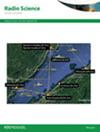Modeling and analysis of artificial periodic inhomogeneities in the ionosphere
IF 1.5
4区 地球科学
Q3 ASTRONOMY & ASTROPHYSICS
引用次数: 0
Abstract
The artificial periodic inhomogeneity (API) technique is an ionospheric modification experiment that creates perturbations in the electron plasma density, studied through the scattering of probing radio waves. This work presents the first comprehensive observation of API irregularities at the HAARP facility including responses from the D, E, and F regions. The measurements were obtained by reprocessing backscatter echoes from an experimental campaign in 2014. To investigate the evolution of these structures, we extend a one-dimensional fluid model previously developed by Hysell and Rojas (2023, https://doi.org/10.1029/2023rs007710), that simulates the formation of API in the E region, incorporating mechanisms that dominate the API formation in other regions. The creation of these irregularities in the D region is accomplished by including a simplified chemical model that contains the reactions necessary for the production of negative ions. In the F region, we consider the inclusion of the ponderomotive force, which is proposed as the primary mechanism to generate these inhomogeneities. The updated model successfully produced API irregularities in the three distinct ionospheric regions according to their respective formation mechanisms. Information about the diffusion process of these structures is obtained by analyzing their decay times.电离层人工周期不均匀性的模拟与分析
人工周期不均匀性(API)技术是一种电离层修饰实验,通过探测无线电波的散射来研究电子等离子体密度的扰动。这项工作首次在HAARP设施上对API不规则性进行了全面观测,包括来自D、E和F区的响应。这些测量数据是通过对2014年一次实验活动的后向散射回波进行再处理获得的。为了研究这些结构的演化,我们扩展了Hysell和Rojas (2023, https://doi.org/10.1029/2023rs007710)先前开发的一维流体模型,该模型模拟了E区API的形成,并纳入了其他区域主导API形成的机制。在D区产生这些不规则性是通过包括一个简化的化学模型来完成的,该模型包含了产生负离子所需的反应。在F区,我们考虑包含有质动势,这被认为是产生这些不均匀性的主要机制。更新后的模型根据其各自的形成机制成功地在三个不同的电离层区域产生了API不规则性。通过分析这些结构的衰变时间,可以得到它们扩散过程的信息。
本文章由计算机程序翻译,如有差异,请以英文原文为准。
求助全文
约1分钟内获得全文
求助全文
来源期刊

Radio Science
工程技术-地球化学与地球物理
CiteScore
3.30
自引率
12.50%
发文量
112
审稿时长
1 months
期刊介绍:
Radio Science (RDS) publishes original scientific contributions on radio-frequency electromagnetic-propagation and its applications. Contributions covering measurement, modelling, prediction and forecasting techniques pertinent to fields and waves - including antennas, signals and systems, the terrestrial and space environment and radio propagation problems in radio astronomy - are welcome. Contributions may address propagation through, interaction with, and remote sensing of structures, geophysical media, plasmas, and materials, as well as the application of radio frequency electromagnetic techniques to remote sensing of the Earth and other bodies in the solar system.
 求助内容:
求助内容: 应助结果提醒方式:
应助结果提醒方式:


